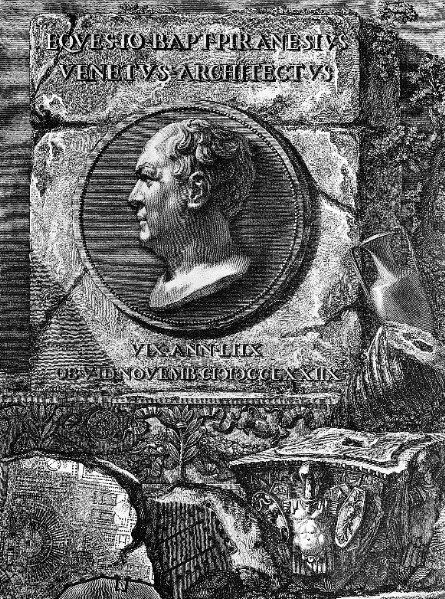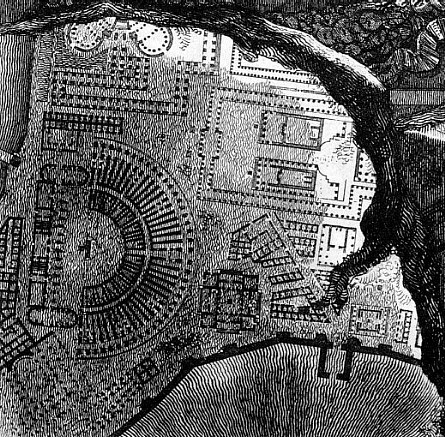"The Key Plan"
1998.02.19
"The Key Plan"... ...about the tiny unnamed intercourse building at the end of the axis of life.
...unlocking secrets, gaining access to knowledge.
...the plan as depicting conception, and therefore the intentional starting point for meaning (and hence interpretation as well).
...the symbolism regarding the conception of Romulus and Remus--Mars and the royal Vestal Virgin as the parents.
...the tiny plan as the generator of all the subsequent plans; the beginning of the "embryonic development" of all the other plan formations.
...the signifying effect of inside vs. outside and of solid vs. void.
...the irony that Bloomer's key plan is just across the river and the unfortunate non-starter nature of her interpretation and underworld scenario.
...the connection to the The City of God regarding the fratricide of Romulus towards Remus and its parallel to Cain and Abel.
the portrait of Piranesi
1998.06.28
There is a portrait of Piranesi engraved by his son Francesco. The portrait is a profile set in a medalion, and the overall composition of the plate is in the Piranesi style. In the lower left corner, there is a stone fragment carved with plans, and it is indeed a fragment of the Ichnographia, specifically the Theater of Marcellus, the Minutia Vetus, and the Porticus Octavae. ...wonder if Francesco, or even Piranesi himself, saw the Ichnographia as Piranesi's greatest achievement. The four-sided Temple of Janus is also clearly delineated on the fragment.
...a case for the father-son theme that begins with Mars and Romulus (inversely God, the Father and His Son Jesus), and could include Augustus and Agrippa, and Trajan and Hadrian, and even Theodosius and Honorius.


Ichnographia Campus Martius
1998.07.12
Piranesi's Ichnographia Campus Martius is a "text" of multiple historical accounts delivered through the combination of two languages. The Ichnographia tells the story of Rome when it was the capital of the ancient Western world. The story begins with Romulus leading the first triumphal march, and ends with the burial of the Emperor Honorius almost 1200 years later. Piranesi relates this urban history through a sequence of dual narratives--life and death, love and war, the profane and the sacred--which signify the continual theme of inversion and occasionally incorporate satire. Piranesi communicates this vast classical treatise through Latin labels which identify the individual buildings within the Ichnographia, and, most often, the written word requires a reading in tandem with the ichnography to grasp the full extent of Piranesi's copious message. This unique aggregate language of word and image, moreover, readily affords a syntax where double meanings are not uncommon, and, hence, befits Piranesi's dual narratives of inversion and satire perfectly.
Stephen Lauf
| |
Romulus
1998.07.17
As the son of Mars, and as founder and first king of Rome, Romulus is synonymous with beginnings. Without Mars, however, Romulus is nothing, so it is through the concomitance of Mars and Romulus that the origin of Rome takes place in Piranesi's Campo Marzio.
The presence of Romulus within the Ichnographia occurs both directly and indirectly. There is the Templum Romuli, and there is the Templum novum Quirini. The Templum Romuli is within the Campus Martius proper, while the Templum novum Quirini is situated further east between the Horti Salustiani and the base of the Quirinal Hill. Both temples, interestingly enough, "preside" over large stadium complexes, and it is worth further noting that the Templum Romuli is on the same axis as one of the Ichnographia's two Templum Martis.
The third and most indirect reference to Romulus is the Lineae indicantes viam triumphalem--the line indicating the Triumphal Way--which begins in the Area Martis in front of the Ichnographia's other Templum Martis that is on the west bank of the Tiber within the Vatican valley. Each Roman Triumph, of which there were hundreds throughout ancient Rome's history, is a reenactment of the original triumphal march of Romulus. The Lineae. . .triumphalem of the Ichnographia therefore literally marks a lineage back to Rome's inception, and thus locates a point of beginning for the Ichnographia Campus Martius as well.
Mars (Martis)
1998.07.23
Tafuri, Manfredo
1998.11.16
After an extended independent analysis of the Ichnographia Campus Martius, it becomes evident that Tafuri misreads Piranesi's large plan in most cases. Tafuri's text indicates no research of the plan beyond simply looking at it and subsequently offering a description of what Tafuri thinks he sees. (In fact, a careful reading of both Tafuri's texts and the text of Fasolo from 1956, clearly shows that Fasolo's text greatly influenced Tafuri's observations.) For example, in calling out the various axes of the Campo Marzio, Tafuri notes the axis running through Hadrian's Tomb, but he fails to recognize it's symbolic function as the Axis of Death; nor does he identify the Axis of Life that runs perpendicular to the Axis of Death. Moreover, Tafuri marginally notes the semblance of an axis within the northeast sector of the plan, yet he never mentions that Piranesi labeled this axis the Equiria, place of the annual horse races instituted by Romulus in honor of Mars.
These are just two examples which plainly demonstrate that Piranesi's plan holds significant and coherent symbolic content, however, recognition of Piranesi's "carved in stone" symbolism necessarily negates Tafuri's primary thesis that the Ichnographiam Campi Martii is utterly fragmented and devoid of "language." Ironically, had Tafuri not discounted the presence of language and instead actually translated the hundreds of Latin labels Piranesi applies throughout the plan, he would have concluded with a more accurate, if not also a more honest reading.
It is truly unfortunate that the subsequent 20th century Campo Marzio analyses of Allen, Bloomer, and Eisenman, build upon Tafuri's mistakes rather than correct them.
Equiria
1998.12.01
According to Festus, it was Romulus who instituted the first horse-races in honor of Mars. These races became an annual event, and, due to their origin, are rightly considered the "proto" festival or feast of Roman tradition. According to Varro, the races took on the name of Equirria, which is derived "from the equorum cursus 'running of horses'; for on that day they currunt 'run' races in the sports on the Campus Martius." Furthermore, Ovid's Fasti lists the dates of the races as the 27th of February and the 14th of March, and, since the Roman calendar began the 1st of March, the holding of the first horse-race the day just before the new year further attests the Equirria's premire "fest" position.
eros et thanatos
2683a
1999.01.29
errors in "speaking architecture"
2000.12.21
...a "display [that generally] deals with the 'language' and meaning of architectural planimetric forms, while specifically [displaying] the 'master key' that unlocks the long held mysteriousness of Piranesi's Ichnographia Campus Martius. ...you see a 'building' [Aedicula Intercorse] that is both literally and figuratively conception. This tiny building is indeed one of the few plans within the Ichnographia that Piranesi does not provide with a Latin label, and that is because the building, through its plan, already speaks for itself, and, moreover, it speaks of all the 'concepts' there involved, namely, Piranesi's conception of architectural language, and the very conception of Rome [Romulus] itself. Piranesi's architectural intensification here is so tight to the point that indeed the medium is the message.
Essentially, Piranesi designed a building deliniating conception, which also represents Piranesi's conception of the large Campo Marzio plan, which also represents the beginning/conception of Rome itself.
...first encountered the word/name Sessorium
2002.06.12
Re: Ichnographia Romaphilia
2004.12.16 13:56
While working with Piranesi the discussion is often enlightening.
"So why exactly did you produce two versions of the Ichnographia Campus Martius and keep everyone none the wiser?"
"Overall, I just wanted to see who would find the two versions first. They were found, eventually (after more than two hundred years), but it's embarrassing for all the Piranesi "scholars" because it wasn't one of them."
"Why do you think the so-called scholars failed? Why did they not see what was always right in front of them?
"Simply put, they never reenacted the source."
"Kahn reenacted the source, and he didn't see the two versions."
"Well, I'd say Kahn was busy manifesting new versions of his own."
"Perhaps it's just plain destiny that Philadelphia itself reenacts the source."
"You know, I love you guys like brothers."
"That's fine as long as you realize that we're all independent as well."
"Ha, tell that to Romulus and Remus."
It rocked Eisenman on his chair...
2007.11.09 10:56
Giovanni Battista Piranesi died today in 1778, on the feast of the dedication of the Basilica Constantiniani (known today as the Basilica of St. John Lateran), the first Christian basilica in Rome.
"Piranesi uses the Rome that was extent in the eighteenth century as a starting point, but that possesses no original value; it is merely a being in the present. From this existential moment of being, he takes buildings that existed in the first and second centuries, in Imperial Rome, and places them in the same framework of time and space as the eighteenth-century city."
--Peter Eisenman, "Notations of Affect. An Architecture of Memory" in Pathos, Affect, Gefühl (Berlin: Walter de Gruyter GmbH, 2004), pp.504-11.
If you actually study the Campo Marzio you'll find the starting point, framework and the millennium's worth of buildings that Piranesi utilized. First there are the altar and race course dedicated to Mars by Romulus in the mid-eighth century BC. Incidentally, this is how the Campo Marzio received its name--the fields of Mars. And to manifest the framework there is the last Imperial artifact of the Campo Marzio, the sepulcher of Empress Maria, wife of Honorius, from the early 5th century AD. Indeed the sarcophagus of Empress Maria holds a key position within the Il Campo Marzio publication. And to complete the framework, the last page of Il Campo Marzio depicts a double theater.
|